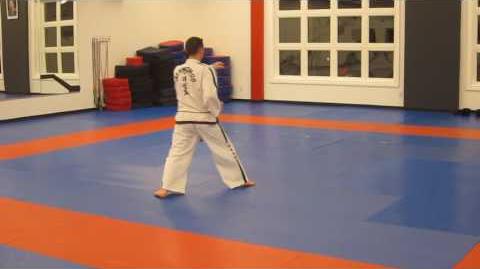
The Monument to the March 1st Movement

Sam-ll is one of the 3rd degree black belt forms used in ITF-style taekwondo. Sam Il, literally meaning "3/1" or March 1, denotes the date of the Korean independence movement (i.e., the Samil Movement) which began on the 1st of March 1919. The 33 movements in the pattern stand for the 33 patriots who planned the movement. (See also: Eui-Am.)
The inspiration for the Samil Movement came from the repressive nature of Japanese policies under its military administration of Korea following 1905, and the Fourteen Points outlining the right of national "self-determination" proclaimed by President Woodrow Wilson at the Paris Peace Conference in January 1919. After hearing news of Wilson’s speech, Korean students studying in Tokyo published a statement demanding Korean independence.
At 2 P.M. on the 1 March 1919, the 33 nationalists who formed the core of the Samil Movement convened at Taehwagwan Restaurant in Seoul, and read the Korean Declaration of Independence that had been drawn up by the historian/writer Choe Nam-seon and the poet/Buddhist monk Manhae (also known as Han Yongun). The nationalists initially planned to assemble at Tapgol Park in downtown Seoul, but they chose a more private location out of fear that the gathering might turn into a riot. The leaders of the movement signed the document and sent a copy to the Japanese Governor General, with their compliments:
- We herewith proclaim the independence of Korea and the liberty of the Korean people. We tell it to the world in witness of the equality of all nations and we pass it on to our posterity as their inherent right. We make this proclamation, having back of us 5,000 year of history, and 20,000,000 of a united loyal people. We take this step to insure to our children for all time to come, personal liberty in accord with the awakening consciousness of this new era. This is the clear leading of God, the moving principle of the present age, the whole human race's just claim. It is something that cannot be stamped out, or stifled, or gagged, or suppressed by any means.
They then telephoned the central police station to inform them of their actions and were arrested afterwards.
Despite the nationalists' concerns, massive crowds assembled in the Pagoda Park to hear a student, Chung Jae-yong, read the declaration publicly. Afterwards, the gathering formed into a procession, which the Japanese police attempted to suppress.
Coinciding with these events, special delegates associated with the movement also read copies of the independence proclamation from appointed places throughout the country at 2 PM on that same day, but the nationwide uprisings that resulted were also brutally put down by the Japanese police and army.
Video[]
Why was this video chosen for use on this wiki? Do you have a better video? Please see Video Guidelines before replacing this video with a better one.
Diagram[]
No diagram has yet been added for this technique. You can contribute to Taekwondo Wiki by adding an appropriately licensed diagram.
Written Instructions[]

The lines of Sam-Il (student view)
- Ready Posture: Closed Ready Stance C
- Step 1. Slide to D forming a right L-stance toward D while executing a middle guarding block to D with the forearm.
- Step 2. Move the right foot to D forming a right walking stance toward D while executing a high block to D with the right double forearm.
- Step 3. Move the left foot to D forming a left walking stance toward D while executing a high side block to D with the right knife-hand and bringing the left palm on the right back forearm.
- Step 4. Execute a middle twisting kick to A with the right foot keeping the position of the hands as they were in 3.
- Step 5. Lower the right foot to D forming a right walking stance toward D while executing a middle punch to D with the right fist.
- Step 6. Move the right foot on line CD to form a sitting stance toward B while executing a middle wedging block with a reverse knife-hand.
- Step 7. Execute a low thrust to C with a right upset finger tip while forming a left walking stance toward C, pivoting with the right foot.
- Step 8. Execute a high outward block to D with the right outer forearm and a low block to C with the left forearm while forming a right L-stance toward C pulling the left foot.
- Step 9. Move the right foot to C to form a sitting stance toward A while executing a middle wedging block with a reverse knife-hand.
- Step 10. Execute a low punch to C with the right double fist while forming a left L-stance toward C, pulling the right foot.
- Step 11. Move the left foot to C forming a left walking stance toward C while executing a high block to BC with a double arc-hand and looking through it.
- Step 12. Move the right foot to C forming a right walking stance toward C while executing a middle punch to C with the left fist.
- Step 13. Move the right foot on line CD to form a right L-stance toward D while executing a low punch to D with the left double fist.
- Step 14. Move the left foot to B forming a right L-stance toward B while executing a high guarding block to B with a reverse knife-hand.
- Step 15. Execute a U-shape block to B while forming a left fixed stance toward B, slipping the left foot.
- Step 16. Execute a sweeping kick to B with the right side sole and then lower it to B forming a right fixed stance toward B while executing a U-shaped block to B.
- Step 17. Jump and spin counter clockwise, landing on the same spot to form a left L-stance toward B while executing a middle guarding block to B with a knife-hand.
- Step 18. Execute a middle side piercing kick to B with the right foot while forming a knife-hand guarding block.
- Step 19. Lower the right foot to the left foot and then move the left foot to A forming a left walking stance toward A while striking the left palm with the right front elbow.
- Step 20. Move the right foot to A turning counter clockwise to form a left diagonal stance toward D at the same time thrusting to C with the left back elbow supporting the left forefist with the right palm and turning the face to C.
- Step 21. Execute a pressing block with an X-fist while forming a right walking stance toward AD.
- Step 22. Move the left foot to A in a stamping motion to form a sitting stance toward C while executing a W-shape block with the outer forearm.
- Step 23. Execute a middle side piercing kick to A with the left foot while forming a forearm guarding block.
- Step 24. Lower the left foot on line A and then execute a low guarding block to B with a knife-hand while forming a left L-stance toward B, pivoting the left foot.
- Step 25. Move the left foot to B forming a right rear stance toward B while executing an upward block with a left palm.
- Step 26. Move the right foot to B forming a left rear foot stance toward B while executing a pressing block with a twin palm.
- Step 27. Move the left foot to C in a stamping motion to form a left walking stance toward C while executing an upset punch to C with a twin fist.
- Step 28. Move the right foot to C forming a left L-stance toward C while executing a low block to C with the right forearm, pulling the left fist under the left armpit.
- Step 29. Execute a middle punch to C with the left fist while maintaining a left L-stance toward C bringing the right fist over the left shoulder.
- Step 30. Execute a middle front block with the right forearm while forming a left walking stance toward D, pivoting with the right foot.
- Step 31. Execute a high punch to D with the left fist while maintaining a left walking stance toward D. Perform 30 and 31 in a continuous motion.
- Step 32. Execute a low front snap kick to D with the left foot keeping the position of the hands as they were in 31.
- Step 33. Lower the left foot to D and then move the right foot to D in a stamping motion forming a right walking stance toward D while executing a high vertical punch to D with a twin fist.
- End: Bring the foot back to a ready position
Black Belt Forms[]
The ITF-style Black Belt forms are:
- Kwang-Gae (39 movements) - 1st dan
- Po-Eun (36 movements) - 1st dan
- Ge-Baek (44 movements) - 1st dan
- Eui-Am (45 movements) - 2nd dan
- Choong-Jang (52 movements) - 2nd dan
- Juche (45 movements) - 2nd dan / Ko-Dang* (39 movements) - 2nd dan
- Sam-Il (33 movements) - 3rd dan
- Yoo-Sin (68 movements) - 3rd dan
- Choi-Yong (46 movements) - 3rd dan
- Yon-Gae (49 movements) - 4th dan
- Ul-Ji (42 movements) - 4th dan
- Moon-Moo (61 movements) - 4th dan
- So-San (72 movements) - 5th dan
- Se-Jong (24 movements) - 5th dan
- Tong-Il (56 movements) - 6th dan
Forms no longer used:
* Ko-Dang is an older form, replaced with Juche. Ko-Dang is still taught in some schools however.
U-Nam is an ITF/Chang Hon-style form that appears only in the 1959 edition of Choi Hong Hi's Tae Kwon Do Teaching Manual.
References[]
The primary reference is:
The following websites are also particularly good online references for ITF-style taekwondo:
